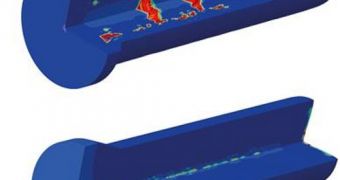As anyone working in shaping materials can tell you, there is a certain limit to the degree of accuracy a press can instill into solids such as metals. From a certain point on, the force the press needs in order to make the modifications starts producing cracks, and perforates the material being shaped, causing imperfections. But now German scientists at the Fraunhofer Institute for Mechanics of Materials IWM, in Freiburg, have developed a computer simulation that shows how this problem can be eliminated.
The investigators say that the auto industry is one of the best examples of how these deformations can cost millions. Luxury-car manufacturers use solid pieces of metal to produce sheets, tubes, rods and bars, which are manufactured by reputed steel companies. It is the job of these companies to ensure that the materials they ship out for further processing are not damaged as they are converted from their original shape to one of actual use. If the temperature in their forming tool is off, or if the metal is excessively deformed, then the end-product would be one of inferior quality.
Another time-consuming and labor-intensive aspect of this work is the trial-and-error process associated with determining the best possible approach to obtaining a certain finished product. Various types of forming tools need to be tested under different sets of conditions, until precisely the right combination is found. And this is where the new Fraunhofer innovation steps in. The new computer simulation is touted as having the ability to drastically reduce the amount of materials being wasted in the trial-and-error processes, and to speed production considerably.
“With our numerical simulation we can calculate how much deformation a component can withstand before cracking. And we can analyze the effect of factors such as press force and lubricants on the properties of the material. We found that by making a specific change to the geometry of a shaping tool unwanted perforations were avoided because the pore density did not rise sharply but only slightly. With our simulation we can identify the optimal properties of components and shaping tools much more quickly than by trial and error,” IWM Project Manager, Dr. Dirk Helm explains, quoted by AlphaGalileo.

 14 DAY TRIAL //
14 DAY TRIAL //